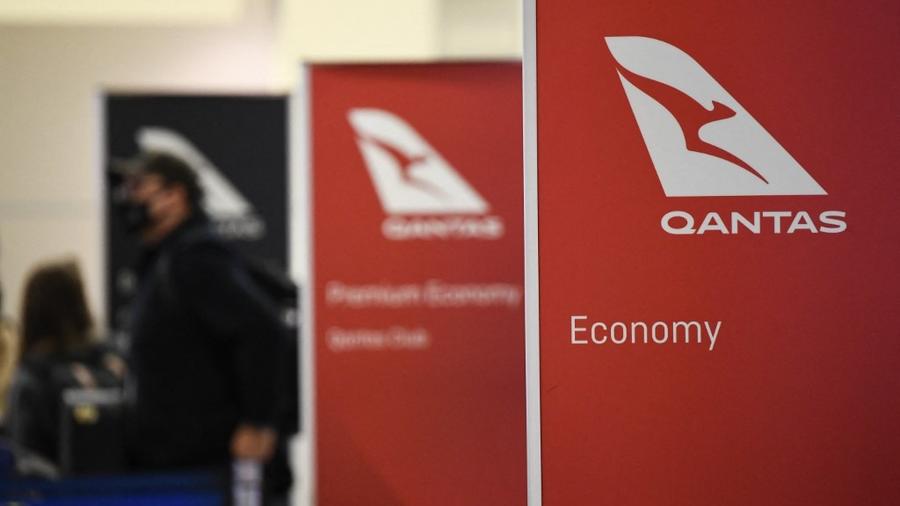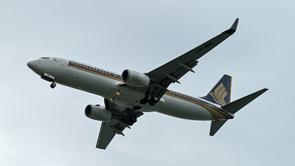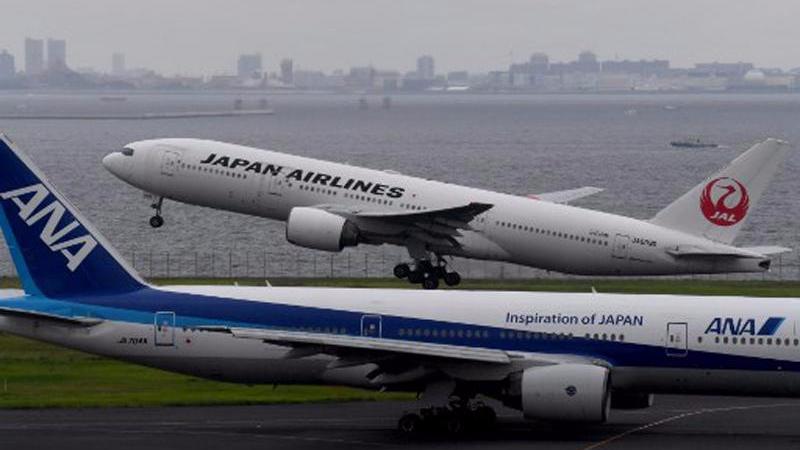 Travelers wait in line after verifying their COVID-19 vaccination status as they check-in for a flight to Sydney, Australia on Qantas Airways Ltd inside the Tom Bradley International Terminal at Los Angeles International Airport on Nov 1, 2021 in Los Angeles, California. (PATRICK T. FALLON / AFP)
Travelers wait in line after verifying their COVID-19 vaccination status as they check-in for a flight to Sydney, Australia on Qantas Airways Ltd inside the Tom Bradley International Terminal at Los Angeles International Airport on Nov 1, 2021 in Los Angeles, California. (PATRICK T. FALLON / AFP)
SYDNEY - Qantas Airways Ltd surprised the market with a stronger-than-expected profit forecast on Thursday that underscored how Asian airlines are recovering from the pandemic at vastly different paces as demand rebounds.
Qantas saw shares surge 9 percent for the day after it revealed results in the first half ending Dec 31 would reach as much as A$1.3 billion ($815.75 million), more than double market expectations, with consumers willing to pay higher fares despite rising inflation and interest rates
Carriers that benefited from strong external funding or government support, earlier openings, large domestic markets and surging cargo rates are thriving, while those with longer-lasting quarantine rules, weaker balance sheets and more aircraft in storage are struggling to gain ground as the economic outlook darkens.
Qantas saw shares surge 9 percent for the day after it revealed results in the first half ending Dec 31 would reach as much as A$1.3 billion ($815.75 million), more than double market expectations, with consumers willing to pay higher fares despite rising inflation and interest rates.
"There is still a massive amount of pent-up demand," Qantas Chief Executive Alan Joyce told analysts, adding that the airline predicts there will be less supply for several years, particularly internationally.
International rivals have been slower to bring back long-haul capacity and the stronger US dollar makes it less attractive for carriers from the United States and Middle East, in a trend that also helped Air New Zealand Ltd to get back in the black this half.
Singapore Airlines Ltd, meanwhile, has also reaped rewards from the city-state's fully opening its borders in April, strong financial support from government-owned investment arm Temasek Holdings as well as its hub position.
ALSO READ: IATA: Asia-Pacific airline traffic recovery to speed up as rules ease
"Given the supply-demand imbalance, air fares and yields have been very high, leading to a return of profitability for those airlines that have been able to bring back a significant amount of capacity," Singapore-based independent analyst Brendan Sobie said.
 In this file photo a Singapore Airlines passenger plane approaches for landing at Singapore Changi Airport in Singapore on June 20, 2022. (ROSLAN RAHMAN / AFP)
In this file photo a Singapore Airlines passenger plane approaches for landing at Singapore Changi Airport in Singapore on June 20, 2022. (ROSLAN RAHMAN / AFP)
Given the supply-demand imbalance, air fares and yields have been very high, leading to a return of profitability for those airlines that have been able to bring back a significant amount of capacity.
Brendan Sobie, Singapore-based independent analyst
This phenomenon, however, could be temporary, with airline profits at risk next year amid weakening demand while capacity rebounds as lagging carriers bring more planes into service, he added.
Joyce declined to provide second-half guidance for Qantas, though he said international fares were likely to weaken from current levels.
Qantas, which suffered from a rise in delays, cancellations, lost baggage and staffing issues this year, said it would invest A$200 million in the first half for additional crew, training of new recruits and keeping aircraft in reserve to reduce delays and cancellations.
ALSO READ: Asia's airlines ramp up flights, offers as virus travel curbs ease
North Asia lags behind
In North Asia, airlines have suffered from a lack of customers, though the outlook is improving as Japan, South Korea, China's Hong Kong and Taiwan ease quarantine and testing rules.
China Airlines Ltd and Korean Air Lines Co remained profitable through much of the pandemic on the back of a surge in cargo rates. The freight market is starting to weaken, but rising passenger numbers will help make up for that lost revenue.
ALSO READ: Asian airlines offer perks to keep grounded elite flyers on board
 A Japan Airlines (JAL) Boeing 777 jetliner takes off beside All Nippon Airways (ANA) jetliner at Haneda International Airport in Tokyo on Aug 2, 2017. (TOSHIFUMI KITAMURA / AFP)
A Japan Airlines (JAL) Boeing 777 jetliner takes off beside All Nippon Airways (ANA) jetliner at Haneda International Airport in Tokyo on Aug 2, 2017. (TOSHIFUMI KITAMURA / AFP)
In North Asia, airlines have suffered from a lack of customers, though the outlook is improving as Japan, South Korea, China's Hong Kong and Taiwan ease quarantine and testing rules
Japan Airlines Co Ltd and ANA Holdings Inc will benefit from the country's opening to visa-free tourist travel this week, with a weak yen making it an attractive destination for overseas visitors.
ALSO READ: Luggage piles join long airport lines in fresh woes for summer travel
Cathay Pacific Airways Ltd, which parked much of its fleet in the desert during the pandemic because of a lack of demand, is struggling to hire enough staff and bring planes back quickly as rules ease.
AirAsia, which has a relatively weak balance sheet, is facing a shortage of maintenance slots as it works to return its fleet to service.
READ MORE: IATA: Asian airlines could lose US$27.8b revenue from virus
Other Southeast Asian carriers like Garuda Indonesia and Thai Airways International PCL have slashed the size of their fleets as they restructure debt, making it harder to grow in line with rebounding demand.



